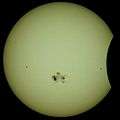Nene
Nene may refer to:
People

Nene (bird)
The nene (Branta sandvicensis), also known as nēnē and Hawaiian goose, is a species of goose endemic to the Hawaiian Islands. The official bird of the state of Hawaiʻi, the nene is exclusively found in the wild on the islands of Oahu,Maui, Kauaʻi and Hawaiʻi.
The Hawaiian name nēnē comes from its soft call. The species name sandvicensis refers to the Sandwich Islands, an old name for the Hawaiian Islands.
Evolution
It is thought that the nene evolved from the Canada goose (Branta canadensis), which most likely arrived on the Hawaiian islands about 500,000 years ago, shortly after the island of Hawaiʻi was formed. This ancestor is the progenitor of the nene as well as the prehistoric Giant Hawaiʻi goose and nēnē-nui (Branta hylobadistes). The nēnē-nui was larger than the nene, varied from flightless to flighted depending on the individual, and inhabited the island of Maui. Similar fossil geese found on Oʻahu and Kauaʻi may be of the same species. The Giant Hawaiʻi goose was restricted to the island of Hawaiʻi and measured 1.2 m (3.9 ft) in length with a mass of 8.6 kg (19 lb), making it more than four times larger than the nene. It is believed that the herbivorous Giant Hawaiʻi goose occupied the same ecological niche as the goose-like ducks known as moa-nalo, which were not present on the Big Island. Based on mitochondrial DNA found in fossils, all Hawaiian geese, living and dead, are closely related to the giant Canada goose (B. c. maxima) and dusky Canada goose (B. c. occidentalis).
Nene (trail)
Nene (pronounced née-nee) is a word in the language of the Seminole Indians. Roughly translated into English, it means "path" or "trail." In the city of Tallahassee, Florida, USA, it is often used in the same way that street, road, drive, terrace, or boulevard are used: following the name of the thoroughfare.
Examples: Ohbah Nene, Chowkeebin Nene, Chuli Nene, Wahalaw Nene.
All of the above are actual examples of nenes that can be found in the Indianhead Acres neighborhood of Tallahassee, Florida.

Sunspot
Sunspots are temporary phenomena on the photosphere of the Sun that appear visibly as dark spots compared to surrounding regions. They correspond to concentrations of magnetic field flux that inhibit convection and result in reduced surface temperature compared to the surrounding photosphere. Sunspots usually appear in pairs, with pair members of opposite magnetic polarity. The number of sunspots varies according to the approximately 11-year solar cycle.
Individual sunspots may endure anywhere from a few days to a few months, but eventually decay. Sunspots expand and contract as they move across the surface of the Sun with a size ranging from 16 kilometers (10 mi) to 160,000 kilometers (100,000 mi) in diameter. The larger variety are visible from Earth without the aid of a telescope. They may travel at relative speeds, or proper motions of a few hundred meters per second when they first emerge.
Indicating intense magnetic activity, sunspots accompany secondary phenomena such as coronal loops (prominences) and reconnection events. Most solar flares and coronal mass ejections originate in magnetically active regions around visible sunspot groupings. Similar phenomena indirectly observed on stars other than the sun are commonly called starspots and both light and dark spots have been measured.
World of Darkness
World of Darkness is the name given to three related but distinct fictional universes created as settings for supernatural horror themed role-playing games. It is also the name of role-playing games in the second and third settings. The first was conceived by Mark Rein-Hagen, while the second was designed by several people at White Wolf Gaming Studio, which Rein-Hagen helped to found. The first two World of Darkness settings have been used for several horror–themed role-playing games that make use of White Wolf's storyteller/storytelling system, as well as Mind's Eye Theatre, a live action roleplaying game based on the core games. The third, Monte Cook's World of Darkness, created by Monte Cook based on the first two World of Darkness settings, includes only a single product.
Terminology and themes
In order to avoid confusing the two product lines, players refer to the most recent version of the World of Darkness line, released on August 21, 2004, as "New World of Darkness", and the previous version as "Classic World of Darkness". Prior to the re-release of cWoD it was often referred to as "oWoD" for "Original" or "Old" World of Darkness.
Penumbra (Star Trek: Deep Space Nine)
"Penumbra" is the 167th episode of the television series Star Trek: Deep Space Nine, the 17th episode of the seventh season. It is the first episode of the series' final 10-episode story arc. The title refers to the shadow effect of the same name.
Plot
On the station, Sisko tells Kasidy Yates of having bought land on Bajor and of his plans to build a house there.
At the bar, Ezri Dax learns that the USS Defiant has given up the search for Worf, who was lost in the Badlands while commanding a Klingon ship attacked by the Jem'Hadar. Ezri decides to take a runabout by herself to the Badlands. Benjamin Sisko from DS9 orders her to return. She unconvincingly pretends that there is too much interference to understand him. Sisko decides to allow her to look for Worf and to send her the Defiant's search log. Dax has the computer extrapolate a likely entry point for Worf's escape pod into the Badlands, then she takes the runabout in and cuts the engine, hoping that the currents will take her to Worf's position.
Podcasts:

